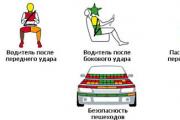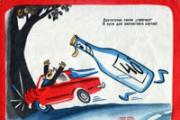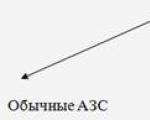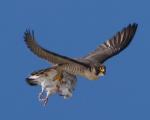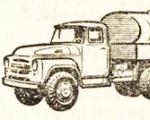In Russian, a black bird with a black beak means the same word. Because of this, confusion arises with the varieties of birds. Raven and crow are completely different birds, although they belong to the same genus of crows (Corvus). They differ in appearance and behavior. Let's take a closer look at both birds. Let's start with the black crow.
Characteristic
The black raven is a massive bird from the order Passeriformes. The body length reaches 60-68 cm, the length of the wings in males is up to 473 mm, in females up to 460 mm. The mass of males is up to 1,560 grams, females - up to 1,315. Wingspan - up to 120 cm.
It is a black bird with a black beak. The plumage is uniform in color: it has a black color and a greenish or bluish tint. Young birds have no ebb. Small feathers at the base are grayish. The beak is very strong, pointed. Claws are powerful, bent. The tail is wedge-shaped in shape, which is clearly visible in flight. The flight of a raven resembles the soaring of birds of prey.
The bird lives in the countries of Eurasia, North America and North Africa. Crow habitats are forest, mountains, coasts.
Behavioral Features
The raven is considered a rare living creature. It is possible to meet a raven in any season. In winter, it appears near human dwellings, in garbage dumps. By nature, the raven is distrustful and prudent. It moves very well on the ground. Before flying, the bird jumps several times. In captivity lives from 15 to 70 years.
Ravens do not always live in the same territories. Some individuals fly away for the winter. In Turkmenistan, after the appearance of young animals, the number of members of the flock is 40-70 individuals, in the Caucasus in winter the flock is smaller - 10-12 individuals. Birds migrate over distances of up to 200 km. During nesting, crows can fly over impressive distances - to the shores of seas and rivers, to the foothills.
Bird nests form in forest areas, avoiding taiga areas. On treeless territories, rocks, cliffs of the coast are mastered. Nests are placed on trees: lindens, oaks, spruces, in mountainous areas - at heights.

Food
The raven is not selective in nutrition, it is quite omnivorous. Its main food is carrion. In this regard, the raven is considered an orderly. He hunts in the steppes, on the mountains, on the banks of the seas and rivers. Raven collects:
- bodies of dead animals - carrion;
- moles, shrews;
- rodents;
- eggs of birds and chicks;
- fish;
- insects, molluscs, insects.
Nesting
Crows are considered to have reached puberty at the age of 2 years. Birds create indestructible couples. Territories for nesting occupy 3-4 km, and sometimes up to 10. Locations do not change. If the nest was destroyed, the raven forms another one in the same area.
A pair usually creates two nests, and uses them at different times. The nest has existed for several decades. Mating games and pair formation begin in early February or a little later, depending on the habitat.
The new nest is built by the male and the female together. It is placed on the tops of different trees: oak, linden, aspen. The height at which the nest is located is usually 20 meters. If the bird is not disturbed, it can build nests near the human dwelling. Nesting structures are located on towers, temple belfries, on the roofs of buildings.
Arrangement of the nest is carried out in the stem forks in the trees. The nest itself is made of strong branches, with wool as a flooring. Egg laying begins in mid-February. The further north the territory, the later laying begins.
The number of eggs laid is 4-6, sometimes up to 7. The interval between clutches is 1-2 days. The size of the egg is 50x33 mm. Color - greenish-blue. Experts do not know for sure whether the female incubates the eggs alone or alternately with the male. Both parents provide food for the chicks. The chicks hatch in mid-May. After that, they live with their parents for a long time, the mortality rate among young individuals is very high. Grown up chicks leave adult birds only in autumn.

Legends and stories
According to biblical tradition, earlier this black bird with a long beak was white. The coloring changed in punishment after the Flood. When Noah released the raven from the ark, the bird did not return to tell the righteous man whether the water had gone, but began to eat the corpses. Noah cursed the raven, and he became black and predatory.
However, it was the raven that fed the prophet Elijah in the desert, so the biblical attitude towards these birds is not always negative.
The legend of the elders speaks of Saint Paul of Thebes, to whom a raven brought a piece of bread every day.
Voron Voronovich is found in the tales of the ancient Slavs. It is he who brings living and dead water.
In England, it was believed that with the departure of the ravens, the monarchy would collapse. For this reason, Churchill ordered the birds to be fed during the war so that people would not be disturbed.
In Stalin's times, NKVD cars were black, for which they were called "funnel".
This is the basic information about the crow. Let's move on to the description of the black crow.

General information
It is a black bird with a black beak. She lives in Europe and East Asia. In Russia, it settles in the Siberian regions and the Far East. Many species of this bird are known.
Black crows are divided into four main subspecies:
- gray;
- eastern gray;
- black;
- eastern black.
The territories of the settlements of these birds often mix, as a result of which new varieties of crows appear. The description of the bird will be considered below.

External Data
The black crow looks like a rook. They belong to the same genus Corvus. She has black feathers with a greenish, bluish or purple tint. This is especially clearly seen when the sun's rays hit the plumage.
The beak and paws are also black. There are small feathers on the nostrils. The tail is rounded. Compared to the raven, this bird has a more modest size. The length of her body is 48-52 cm. It weighs 700 grams.
Behavioral Features
The crow is a bird that creates pairs. In winter, they can form flocks and occupy the nests of other birds. Often they get their own food in the same area as rooks with magpies.
The crow makes characteristic sounds. You can easily recognize this bird by its voice. Her voice has one timbre, the bird utters a cry of "k-r-a-a." Sitting on the upper level of the tree, the crow behaves noisily, because it croaks many times without stopping, forming only short pauses.
Sometimes the croaking lasts for hours. In intervals, the bird changes its location. The flap of her wings is unhurried, there is no haste and fuss in her flight.
The black crow feeds on carrion, grains, insects, mammals and human food waste. In search of food, birds fly to human settlements. The crow finds food in the garbage dumps not far from human houses. However, finding products better than ordinary garbage, he will prefer them. There are cases when urban crows easily stole food from stores during unloading.
Offspring
Reproduction of crows begins when they reach the age of two years. Birds make pairs. Nests are built from reliable branches and placed on the tops of buildings or treetops.
In places where there is no person, the nest can be located on the ground. The female incubates the eggs. Their number is 4-6 pieces. The male takes care of the food of the family. After 17-19 days, chicks appear. At first they are naked, and after a month they are covered with feathers.
Grown up birds do not always form their own families, often continue to live with their parents and help feed new generations of chicks.

Interesting stories
A crow is a bird often called a winged rat for its intelligence and courage.
When feeding chicks, adult females pre-soak bread in puddles.
Crows are able to reproduce the sounds of human speech. Ornithologists say that these birds can solve the simplest logical tasks. Birds distinguish traffic signals. When red, they slowly eat carrion on the road. With a green signal, they fly away quickly.
Experts recorded the entertainment of crows. Birds near the tennis court got a ball and began to drive it along the roof. The game ended only when the ball rolled down from the roof.
Crows steal the eggs of large birds - bustards and little bustards. They love to eat other people's eggs.
In nature, a bird lives 10-60 years.
So, what is the difference between these birds?
Differences in manners
Raven and crow differ in nuances of behavior. These include:
- Flight feature. The raven flies in the same way as other predators - it flaps its wings heavily and leisurely. The crow, on the other hand, waves often and lightly. Her flight is faster.
- Start of flight. The crow starts its flight by jumping, and the crow takes off immediately.
- Various sounds produced. The raven croaks and the crow clicks.
- Raven intelligence. This bird is considered very smart and developed, in terms of intelligence it is not inferior to primates.
External differences
In appearance, it is difficult to confuse the two species of these birds. A raven is a very large bird up to 70 cm long, it is one and a half times larger than a crow. The crow has a more modest size - up to 56 cm long.
The plumage of birds also differ. The feathers of the raven are pure black, the feathers of the crow are black and gray.
The shape of the tail of a raven is wedge-shaped, while that of a crow is rounded.
In a raven, the goiter has a shaggy plumage, in a crow there is no plumage at all.

Differences in lifestyle
Many differences can be seen in the way of life. Raven, having reached adulthood, finds a mate to whom he remains faithful throughout his life. The crow is looking for a mate only for the nesting period. The rest of the time she lives in a pack.
The raven builds two nests, which, together with the female, use them in turn for many years. Migration of the crow family is rare, only when there is a real threat. The nests of these birds are high, it is almost impossible for a person to find them. In addition, the nest has an impressive size.
A crow may well build a nest where a person lives. Most often, these birds live in various settlements. The behavior of the crow in the city indicates a good adaptation of birds to such living conditions. You can see the lack of fearfulness and their restrained caution.
Birds are able to distinguish people. They watch who approaches them, are able to critically assess the situation and build their behavior. Depending on the situation, the bird either flies away or continues to watch the person.
When combined in flocks, birds become aggressive. They can attack animals - cats and dogs. In a flock, birds are sensitive to the behavior of its members. If someone shows concern, the pack will respond responsively.
Ravens love to stray into flocks, and they adjoin the groups of rooks and jackdaws. In autumn, such flocks move great distances. The raven does not join flocks - it makes any flights alone.
The chicks are also different. In a crow, the chicks are large, a month after the appearance they practically do not differ from adults. They leave their parental nests early. Crows have much smaller chicks, they are in no hurry to leave their parents.
Other differences
In addition to those listed above, there are other differences:
- The raven lives on lands with subtropical and temperate climatic conditions in Eurasia and North America. The crow settles in Eurasia and Northeast Africa. This is the essential difference. Crows have a much more modest habitat.
- Life span. The lifespan of a raven is much longer than that of a crow. The average life span of the latter is 8 years. There are legends about the life of a crow, according to which they can live up to 300 years.
- The crow is not embarrassed by the neighborhood of a person. She settles quietly in cities. Raven is used to living alone or in pairs.
Are there common features?
Despite many differences, there are common features that unite these black birds with a black beak. Here they are:
- Both those and others feed on carrion, performing a sanitary function. Both species of birds are omnivorous and do not disdain any food.
- Both of them have a developed intellect. Both types of birds have their own language, they are capable of logical thinking, they know how to handle tools, imitate human speech. It is even possible that these birds can count.
Be that as it may, both the raven and the crow are beautiful birds that live next door to us.
Today I propose to get acquainted with the most synanthropic bird - the gray crow. Absolutely all residents of cities and villages know this bird.
A bit of biology
First, let's talk about systematics. As a separate species, the crow (Corvus cornix L.) was described by C. Linnaeus together with a species close to it - the black crow (Corvus corone L.). Further research found that in the vast areas of contact, black and gray crows form mixed pairs, give full-fledged offspring capable of reproduction. This indicates that the gray and black crows in nature have not yet reached the complete reproductive isolation characteristic of the present species. Therefore, taxonomists combined the black and gray crows into one species - the crow (Corvus corone), giving them the rank of subspecies. Under a single species name, the gray and black crows are included in systematic summaries and large monographs. However, a 2002 study showed that hybrids are not born in all cases and are inferior in health to purebred birds - a sign of the formation of a new species, its separation from the parent species. Now the scientific name of the gray crow is Corvus cornix (actually just "crow"), and the black crow is Corvus corone.

Gray crow (lat. Corvus cornix) - a species of birds from the genus of crows. Outwardly, the gray crow has a large black beak, their plumage on the head is black, the neck and part of the hind back are ash-gray, the wings are black, but in the sun they acquire reflections of green. Black tail and paws. The underbelly is also grey. The crow's tail is wedge-shaped, with long tail feathers. The bird's beak is powerful and sharp, conical in shape, in some species it has a characteristic high bend. The legs of the crow are thin and long, with four fingers: 1 is turned back, 3 is forward. And a rather graceful body structure. On the ground it moves with wide steps, in case of danger it begins to “jump”. An adult bird weighs from 400 to 700 grams, and the body length is about 50 centimeters, while the wingspan reaches 1 meter. Distributed in Eurasia, where it reaches the Yenisei. A sedentary nomadic species, completely disappears in winter only from the northern periphery of the range.
Crows are omnivorous birds, they feed on insects, chicks and eggs, rodents and lizards, frogs, fish; plant food - the seeds of various plants, as well as the plants themselves, as well as food waste and carrion, which is of great importance for sanitation.

The Hooded Crow starts nesting in March-April (depending on the climate). When crows build nests, they separate from the flock and try to protect the boundaries of their area. In cities, the widespread breakdown into pairs and mating games can be observed already in February. The earliest chicks appear not earlier than April, in one clutch there are 3-6 eggs, less often up to 7-8. As a rule, birds do not use old nests; they make new ones, but not far from the old ones. In the wild, birds breed at a distance of 1-2 km from another pair, in the city this gap is much less. The breeding season is preceded by a current with air games, chases, somersaults in the air. Partners build a new nest every season. The Hooded Crow starts nesting in March-April (depending on the climate). Bird nests are arranged in parks and squares, in the fork of thick tree branches, power line supports, cranes, behind drainpipes. Crows build nests from dry branches or reeds, fastened with clay and turf, in addition, they often use wire, line the nest with feathers, grass, tow, cotton wool, rags, and synthetics. Near the nest behaves cautiously and imperceptibly. As is known, the limits of clutch volume in birds are a genetically determined trait. In crows, the minimum full clutch is 2 eggs, the maximum is 6, and the average clutch contains 3 to 5 eggs. The female lays 4-6 bluish-green eggs with dark speckles, from the end of March to May.


They are incubated by one female, for 18-19 days, without leaving the nest around the clock, the male feeds her during the incubation period. After 25 days, the chicks hatch and are fed by both parents. Growing chicks need food that is easy to digest and high in calories. The best food for them is the eggs of other birds. Ravens ruthlessly plunder other people's nests to feed their chicks. The chicks fly out around the middle of June, for some time they stay with their parents who feed them. In July, family flocks break up.

By autumn, crows are concentrated in large numbers around landfills, garbage dumps and other sources of food. They reproduce in the 2nd-5th year of life. The maximum accurately known age is 20 years.

Interesting Crow Facts
The crow is a professional scavenger with concentrated stomach acid, high body temperature, and resistance to a vast number of infections. It is from her that a person practically does not have a chance to pick up an infection. Moreover, by exterminating dead birds of other species, as well as the carcasses of mice and rats, crows prevent the spread of many infections.
In Moscow, at the Rizhsky railway station, half a century ago, biologists noticed that the crows perfectly learned the schedule of suburban trains and learned to fly up to the platform just when the train was approaching the platform. Birds quickly flew into all the vestibules in turn, looking for scraps thrown by the passengers of the last flight. Moreover, sparrows and pigeons living there have learned the habits of crows, and to this day, bird patrols regularly fly over trains.
Ravens hide their prey, taking care that no one sees it. If another bird suddenly witnessed such an action, the prey will be hidden, but only when the unexpected witness disappears.

Female crows are quite picky in choosing a partner and look for certain qualities or traits in them. A good chosen one should be able to provide for a "family" and be smart enough. Males do everything to attract female attention: dead loops, flying upside down, and other aerobatics.
Crows communicate with each other, the crow language is extremely developed, has a rich "vocabulary". It has special sounds for courting the female, addressing the young, gathering, cursing, threatening, alarms, distress. Sometimes several birds make the same sound, in unison. For more volume. In cases where a general fee is declared. The sounds made by crows fit into the range from 0.5 to 4.0 kHz. And here's what is remarkable: in different countries these birds have their own dialects - they do not immediately understand each other.

Crows leave most of their droppings under their nests, which they build in trees (you definitely shouldn’t park your car there). The crow, the only bird, can be taught to use the toilet - precisely because the bird knows how to control this process, tries not to dirty it in its nest, and usually empties its intestines when flying out and flying into it.
Ravens create one pair for life. In the event of a predator approaching, males can sacrifice themselves to save their soulmate and chicks.
There is another oddity in the behavior of birds, whom the crow dies, her comrades arrange a memorial service. Having found the body of a dead bird, for fifteen minutes they fill the space with heartbreaking cries, as if on command, the birds wipe, sit on the branches and mournfully remain silent. Modern researchers cannot explain this phenomenon.
Crows can count. If a crow is given a choice of two feeders with different amounts of food, it will almost always choose the one with more food. For example, 14 beetles were placed in one feeder, and 15 in another. A person could not immediately determine where there were more beetles, but the crows did it with ease. In addition, crows learn to recognize numbers very quickly and subsequently can even determine which number is larger and which is smaller!

Ravens do not just remember their offender, they transmit information to other birds. Surprisingly, even "children" will be hostile against those whom their parents have "cursed".
City crows love games, they are not afraid of dogs and cats. In the forest, birds often play with predators, people have watched the birds chase a fox, a wolf or an otter. In winter, people often watched the birds roll from the icy mountain and church domes. And crows love team games. One of the birds holds some small object in its beak, it can be a stick, a bump or a stone. the crow takes off heavily and passes the “pass” to another player. This continues until the toy is on the ground.
So, crows correctly determine the meaning of traffic lights - at red light they calmly pick up the corpses of animals hit by cars on the road, and at green they fly away. They perfectly distinguish what is in the hands - a person's stick or a gun, they distinguish between a child and an adult, a man and a woman. But it seems that this is not the limit and the crows are capable of more. They can do extraordinary things. Stop, look around, assess the situation. Recall what you have seen before.
In frosts, they sit down for the night, and closely nestle against each other, putting their heads under the wing and fluffing their feathers, which retain heat well.
Gray crows not only speak, but also master exactly the language in which they communicate with them. If a crow begins to imitate a voice, it does it with such intonations that you cannot distinguish the voice of a person you know from the voice of a crow.

The crow, unlike other birds, eats the contents of a stolen egg far from the crime scene and prints it from the blunt end. To transport the stolen bird punches a hole in the egg, inserts the upper part of the beak into the resulting hole, holding the prey from below. And so, with her mouth open, she leaves the scene of the crime.
In addition, crows have excellent memory and high learning ability. According to experts, they have the ability for rational activity, exhibit associative and logical thinking, possess elementary mathematical knowledge (count up to five, distinguish between shape, symmetry, size ratio, three-dimensional bodies and flat figures).
If in any place the nesting population of crows grows too large, the birds themselves reduce the number of offspring. Large overpopulation affects the growth of aggressiveness of crows, and they ruthlessly destroy the nests of their relatives.
When the bird finds dry bread, it will not immediately eat coarse food. The bird will look for a source suitable for any puddle, wait until the crust softens.
The crow dropped a crust of dried bread into the stream, and it disappeared into the pipe, carried away by the fast current. At first, the bird settled down at the entrance to the pipe and peered into the darkness for a long time. Then she confidently went to the opposite end of the pipe, where she waited for the lost prey. That is, the crow was able to correctly predict the course of events and showed the ability to extrapolate.
There were cases when a crow, protecting its offspring, threw small stones at people approaching the nest.
Means of communication. The sound signaling of birds is especially diverse. If chickens make 13 different sounds, roosters 15, tits 90, then rooks - 120, and gray crows - up to 300 (!). Most researchers are convinced of the signal nature of these sounds. With their help, birds convey a general emotional and mental state - anxiety, aggressiveness, joy from communication or pleasure when finding food. However, some ornithologists believe that birds have their own language, which is a means of communication, communication to convey certain information.
The gray crow is one of the most synanthropic representatives of corvids, a typical inhabitant of cities. There are both completely sedentary urban populations, and populations nesting in natural landscapes, as well as transitional ones. Many individuals living in forests, rural areas spend the winter in the suburbs and cities.
When feeding on a relatively compact food source (a waste bin, a large piece of hard-to-separate food, etc.), group members are fed in a relatively strict sequence. Filming data of feeding groups make it possible to single out three hierarchical stages (strata). Priority is always on the side of the local adult couple. From the feed, they can displace and expel any other member of the group. Conflicts rarely arise between members of a couple. When feeding one of them, the second waits nearby, maintaining an individual distance and a certain orientation in relation to the partner. In the absence of hosts, priority in feeding passes to some individuals of the second hierarchical level. This usually includes all birds of local origin (including first years) included in the group, as well as part of the immigrants. Within this hierarchical stratum, a linear-type hierarchy is observed, but not as rigid and stable in time as between strata. The third hierarchical stage, as a rule, consists of birds from mobile groups, temporarily feeding as part of a settled group.
Watching these birds, you can see: if a person is just walking down the street, the crows do not seem to notice him and can let him in 2-3 meters. But as soon as he stops and looks at them closely, they immediately bounce 10 meters away.

There is a famous Aesop's fable about how a crow threw stones into a jug to get to the water. Scientists decided to reproduce the events of the fable. Moreover, they did it with different crows four times and got the same results. A crow, a deep container of water in which tasty worms swam, and a pile of pebbles were placed in a cage. Crows just couldn't get worms. The results are amazing - 2 crows managed to find a solution on the second attempt, the rest figured it out the first time. At the same time, they began to throw not just any pebbles, but chose the largest ones. And they threw it exactly until the moment when it was possible to pull the worms out of the rising water.
In the 1950s and 1960s, Leonid Viktorovich Krushinsky, a professor at Moscow University, conducted the most interesting research on the abilities of animals. He proved that different animals act intelligently in a new environment for them, and not just on the basis of unconditioned and conditioned reflexes.
Ravens enjoy a very strange activity called enting. It consists in crushing the ants and rubbing them into the body. When the ants are crushed, formic acid is released, which is absorbed into the crows' skin and seems to give them a very pleasant sensation. Why are they doing that? No one knows for sure, but there is no shortage of hypotheses. According to one such hypothesis, enting is a form of ant cooking that renders ravens immune to formic acid. This allows the crows to eat the ants without adverse effects.
Others believe that enting is a learned behavior or instinct that birds can't do anything about. Maybe formic acid is used as a kind of bath oil and has a soothing effect on the skin of birds. At the same time, the enting birds seem to be in a state of complete bliss. Maybe it's actually much simpler. And perhaps crows and other birds cover themselves with squashed ants simply because it gives them pleasure.
Ravens are able to ride on snowy hills, solely for the purpose of entertainment. It is not uncommon to see crows playing with other animals, most often cats and dogs. And in the wild - otters, wolves. In the game, the crow can use sticks, cones, balls and other objects that it finds nearby.

Origin of the species and description
The raven is the largest member of the corvid family. This family is one of the representatives of the numerous order Passeriformes. The voice of the raven is loud and sharp, with a characteristic vibration. In addition to the well-recognized croaking and croaking, the bird can make separate, rather complex sounds and even imitate other voices. The origin of the name raven has its origins in the word crow, which means black. There are many legends associated with the acquisition of a raven of such a gloomy color.
The raven is undoubtedly one of the most ancient creatures on earth. It is difficult to find another such bird, which would be dedicated to such a number of legends and mystical traditions as a crow. He was worshiped and feared by American Indians, harsh Scandinavians, African tribes and peoples of the north. There are multiple references to the raven in ancient manuscripts.
So the cuneiform, dated to the 3rd century BC, tells of a wanderer who escaped on a ship during the universal flood. According to legend, he released a raven, a dove and a swallow from his ship so that they could find land and food. Of all the birds, only the raven managed to find land. The intelligence of a raven is a long-known and indisputable fact.
Appearance and features

The raven is a bird that everyone has seen and heard. But not everyone will be able to distinguish a real raven from relatives close to him. Those who are often mistaken for a crow actually turn out to be a rook or a crow. It is not at all difficult to distinguish a real raven, just look closely. The raven is a large bird, the body length can reach 70 cm. The wing length is up to 47 cm. In a state of wingspan, the wings can reach up to 140 cm. Females are somewhat smaller than males, but apart from size, external signs are practically indistinguishable. The beak is sharp, massive and very large.
Video: Raven
Another distinguishing feature of the raven is pointed, ruffled feathers on the throat in the form of a “beard”, which is especially pronounced during the “singing” of the bird. An adult raven has a completely black color, with a bluish tint. The wings of the raven are long and narrowed, the tail is wedge-shaped. The claws of the bird are powerful, sharp, completely black. The bird in flight can also be distinguished, the flapping of the wings is rarer than that of other closely related representatives. The way a raven flies is admirable, it can soar for a long time in the sky like an eagle.
The life expectancy of ravens in nature is up to 15 years. In captivity, where there is a complete absence of external enemies and stable nutrition, the duration increases to 40-50 years.
Interesting fact: In London, on the territory of the Tower Castle, ravens are in the official service of His Royal Majesty, where they are under the strictest protection.
Where does the raven live?

Due to its unpretentiousness to food and climate, the crow can be found anywhere. It can be the Arctic coast and even the tundra. On the northern ridge, it is more common on rocky seashores and in vegetated river valleys. In the middle lane, it prefers wooded areas with broad-leaved or coniferous forests. Edges with open areas near water bodies and swampy places. Crows try to avoid continuous taiga massifs. Closer to the southern latitudes, the bird settles more readily in hilly areas, does not bypass island and floodplain forests in the middle of the steppes.
If earlier it was believed that the raven avoids proximity to humans, then since the middle of the last century there has been a steady tendency for the bird to move closer and closer to human habitation. In the northwestern territory of Russia, birds began to actively build nests in the suburbs. Including such a large metropolis as St. Petersburg, where they have not been met before. The raven began to pay much less attention to the person, although he was always careful with him. Cases of nesting on high-rise buildings in large cities have become frequent.
Most often, the raven moves closer to the person with the onset of winter. Due to the high snow cover and the decrease in the number of active animals, it becomes more difficult to get food in nature. In the city, crows can often be found at dumpster locations.
What does a raven eat?

The raven is an omnivorous bird, it is often called the orderly of nature, and so it is. The crow is also called a scavenger. Yes, a bird eats dead animals with pleasure, but at the same time only fresh meat, a rotten animal is unlikely to interest it. It is not averse to hunting for any small game itself, while it can hang for a long time, hovering in the air. The sight of a raven is quite sharp and, having chosen a victim, he rushes at her like a falcon.
Raven prey in the wild is usually:
- lizards;
- frogs;
- chicks of other birds;
- large beetles and larvae.
Gets from him and poultry, for this he is very disliked by the villagers. If a raven finds someone else's clutch with eggs or chicks, they will not be in trouble. In addition to all living creatures, the bird gladly consumes plant foods: cereals, fruit crops. So the gardens also get it. The raven is an amazingly intelligent and observant bird, and will never risk himself in vain. He can watch the object of hunting or competitors for a long time, and after waiting for the right moment to pick up his prey.
At the same time, the crow cannot be called a greedy bird. Very often, having found a fallen animal, the raven convenes its relatives, while the size of the prey does not really matter. Ravens often hide the remnants of food by burying them in reserve. Burying and digging is one of the raven's favorite pastimes.
Features of character and lifestyle

The raven is one of the smartest living creatures on earth. It is noticed that before doing something, the raven quite accurately assesses the situation. And it works as useful as possible, excluding unnecessary movements. Scientists have repeatedly studied the mental abilities of birds. Experiments on intelligence led them to the conclusion that the raven has intelligence. It turned out that the bird quickly orients itself in the proposed complicated situation. An experiment conducted by ornithologists is well described.
The essence of the experience was as follows. The crow was offered a rather narrow transparent vessel with water, where a delicacy in the form of worms floated. Stone pebbles were laid out nearby. The raven, which could not reach the worm, quickly realized that it was possible to throw pebbles into the water, thereby raising the water level. In addition to the stones, there were other objects in the pile that did not sink in the water.
The raven thought of pulling them back so that they would not interfere. Thus, the bird quickly got to the delicacy. For the purity of the experiment, this experiment was repeated, and with other crows the result was the same. It has been noticed that the raven often uses improvised objects in order to get food.
The ability to wield auxiliary means is transmitted to young crows in the process of observing adults, so it cannot be called innate. The way the raven drinks also confirms his high intelligence. If most birds take water in their beaks and then raise their heads to make it glass, then the raven does otherwise. He puts his open beak on the water, while turning his head to one side, as a result, the water itself flows into the cavity, he can only swallow it.
Despite the outwardly serious appearance, the raven is a very playful bird. Young crows are very willing to play with various objects, hiding them after playing enough. Moreover, other animals can be involved as an object for their fun, while observing the necessary caution.
Social structure and reproduction

In its natural habitat, the raven is very faithful to its mate. In the second year of life, the raven reaches sexual maturity. Created couples maintain relationships for a long time. The mating season of ravens begins in winter in February. Mating is preceded by long flights over the object of one's desire. At the same time, crows do not just fly, but perform various complex aerobatics, demonstrating their abilities. Both partners participate in the construction of the nest, they build a dwelling, usually on a tall tree in a dense crown.
So - in other places inaccessible to enemies. The frame of the nest is made up of thicker branches that are intertwined. Large holes are braided with thinner branches, often clay is used as a building material. From the inside, a litter is equipped, which simultaneously serves as a heater. As a heater, any material suitable for this is used. It was noted that when choosing a litter, the crow takes into account the climatic features of the area. A crow's nest can be over one meter in diameter.
March is the time for laying eggs. The female crow lays from 2-6 eggs of a grayish-blue color with brown patches. The incubation period lasts from 20-23 days, and both partners often participate in this. The chicks that have appeared have an excellent appetite, both spouses also have to feed, but usually the male does this. When the chicks hatch, the weather, especially at night, is very cool. The female crow practically does not leave her chicks for the first days, continuing to warm them.
About 10 days after birth, young crows begin to learn to fly. First, flying to a neighboring branch, and at about 40 days of age, they already confidently take to the wing. Until the winter, they continue to live with their parents, adopting survival skills.
Interesting fact: Raven is very loyal to his brood. There are cases when even a wounded raven continued to hatch its offspring.
Natural enemies of ravens

The raven, in search of carrion, has to coexist with these predators, and if he loses attention, he himself can become their prey. As for the threats to the crow in the city, there are much fewer of them than in the wild. In an urban environment, the constant proximity of a person somewhat dulls the raven's caution to surrounding dangers. Stray dogs and even cats can take advantage of this factor. But such cases are quite rare, and this is another possible reason for the migration of ravens to the city limits. The most important enemy for the raven in a certain period of history was man.
Interesting fact: It has been noticed that throughout life, crows often continue to communicate with close relatives, flying to visit each other.
Population and species status

In the old days, especially in the 19th century, the raven was persecuted by humans. He was considered a symbol of misfortune and a harbinger of troubles, in addition to this, the raven was accused of destroying crops. All this led to the fact that they began to actively destroy the bird, including with the help of poisons. This caused a sharp decline in the population. Later, some European countries began to correct the situation by taking the raven under protection. Such measures have borne fruit, and the number of crows began to increase.
An obstacle to the increase in the crow population in some regions is the difficult winter conditions, which make it difficult to forage. Assimilation by man of new territories, then leads to an increase in the population of the crow in this region. The explanation is simple: where there is a person, there will always be food waste. The classic black raven is widely known to all inhabitants of the European part. But the detachment of ravens is quite numerous and is not limited to this species only.
Depending on the geographical location, the following types of ravens are known:
- Antillean raven;
- New Koledonian Raven;
- White-billed raven;
- Gray raven;
- American Raven;
- piebald raven;
- Brilliant raven;
- Floresian raven;
- Cuban Raven;
- Cape raven;
- Giant raven;
- Pygmy Raven;
- Raven of Bismarck;
- Jamaican raven;
- Guam Raven;
- Desert Raven;
- Trumpeted raven;
- Palm raven.
Some of the above species of crows are distributed in a rather limited area and their populations are rather small. Others live more widely, but more often within the same continent. The classic black raven, the most adapted to any habitat, thanks to which we know it for what it is.
Raven Guard

To suggest that the raven is a rare and endangered bird species is quite difficult for some. On the territory of the Russian Federation, at this time, the common crow as a species is not threatened with extinction. Which cannot be said with certainty for some Western European countries.
In some countries, including Germany, the raven is under state protection and is listed in the local Red Book. Once upon a time there were plenty of ravens. But "thanks" to much of church politics based on superstition, the crow began to be actively destroyed. This led to the fact that most of the crow population in western Europe was destroyed.
In the second half of the last century, ravens were taken under active protection. In the German Alps there are ornithological stations where the migration of ravens is monitored by ringing. For a more detailed study of the behavior of these extraordinary birds, some individuals are specially kept in spacious enclosures.
The data obtained helps in the work on maintaining and increasing the population of the raven in the natural environment. The way the Germans relate to wildlife, using the example of a bird that is not the rarest on earth, deserves all respect. All these measures are bearing fruit, and the number of crows there is gradually increasing.
We often do not notice those who surround our lives. Crow- an amazing bird, watching which can bring a lot of positive emotions and discoveries. A bird that rightfully occupies the intellectual peak among birds. To understand this, it is enough to put aside your affairs and watch her. And it is possible that the raven will teach us something new. Like enjoying the simple things in life.
The common raven is the largest of the corvid family. The wingspan reaches one and a half meters, the body length is 60–70 centimeters, and the weight is about two kilograms - this is about two times more than the usual, urban gray crow.
An adult healthy raven has a beautiful plumage with a blue tint. Often they are bought as a gift to a child, for an "image" or as an interior decoration. In the bird market every spring, poachers sell about 60-80 crow chicks, which were taken from their parents' nests. Many chicks are sold two or three times - disappointed in the purchase, people bring them back to the sellers. But more often such ravens are simply released into the "freedom" - grown at home, such birds do not live long on the street. For a long time with the owners of only a few. There are no real shelters for wild birds in Moscow, just as there are no rehabilitation and reintroduction centers for birds within the city. There are several forums and clubs for corvids who pick up dying birds, treat and care for them. The Village talked to people who have wild crows at home and learned how life changes with their appearance.
Anastasia and Raven Clara
How did the raven appear in the house
Clara became our first big bird. Before her, I had a maximum of parrots. Another dog, all sorts of rats, mice, rodents. And now we have two crows. The raven is a fairly complex bird in terms of keeping and communicating with it. Clara didn't stay long with her previous owners because she was young and the little crows are destructive out of curiosity. My husband and I took her in, although it was a spontaneous decision. They just didn't know what they were getting into. In June, it was ten years since she appeared with us. In captivity, crows live for about 40 years, the record is 70, it seems, in the Moscow zoo.
About life with a raven
When a wild bird, not adapted for home keeping, appears in an apartment, everything changes. First, she destroys everything she can, and then a suitable environment is created for her and a place where she most of all hangs out, eats, sleeps. In this place, it is better to close the wallpaper and remove the parquet, because the crows are very fond of wallpaper and parquet. We used to have a one-room apartment, and we lived with Clara in the same room, now we live in a two-room apartment - she lives separately, and she is more free.
Crows, like all birds, poop everywhere. You need to constantly do the cleaning or endure the stench and dirt everywhere. She can walk and spread the feces throughout the apartment, get her feathers dirty herself. Therefore, you need to bathe her periodically. It's easy: you put a bowl of water, and she splashes in it, washes herself.
She eats, in principle, everything, a diet like a dog's - meat, all kinds of cereals, cereals. Clara loves vegetables, fruits, but selectively. Ravens have a number of food prohibitions - sweets, citrus fruits, chocolate in no case, coffee is not allowed, very fatty and salty is not allowed. Now I work full time, I used to stay at home - it was better for her. Therefore, she is harmful, they spend little time with her. She is not so dependent on the society of a person in terms of playing or being stroked, but she is simply pleased when a person is nearby. She needs someone to look at. Sometimes she goes out into the corridor from her room, sits on the nightstand and just looks. She cleans herself, does her own business, but at the same time she needs to understand that a person is here, nearby.
About Clara's intellectual abilities
Crows are very capricious and sometimes aggressive. I know cases when a raven began to be jealous of his master, attacked other people. They peck very painfully, they can bite through to the blood. They can bite with their claws. The bird is large, and it is not easy to escape from it, here I immediately recall the Hitchcock film The Birds. There is always the fear that a raven might peck out an eye. It depends on the nature of the bird.
Crows are on your mind. It is difficult to say whether they are evil or good. We still have a good Clara. For some reason, there were no incredible special stories in ten years. She is very calm and a homebody, she doesn’t really like to walk, some kind of trips. Sometimes naughty, something drags. She loves to steal cutlery: they are interesting, shiny, you can hide them somewhere, play with them.
She recognizes people, and she knows what is possible and what is not. If something is impossible, then you can do it imperceptibly. Periodically checks people on whether they are afraid of her or not. A new person comes, she immediately “bulls” at him: she fluffs up, becomes twice as large and begins to walk menacingly at him. If a person is frightened, Clara will follow him all the time and scare him - trying to peck for slippers, for a trouser leg, scoff. And if a person has shown that he is not very afraid of her, she will be careful towards him. Basically, she's more of a coward.
Ravens are mockingbirds, they are very fond of imitating, and in about rony, and a thief about We love to imitate sound. But ours does not speak yet. To be honest, I don't know how to teach. Here with parrots they often do it on purpose. I heard stories about a crow that learned to laugh, imitate the sound of an alarm clock, repeat some words; there are several channels on YouTube where talking crows do all sorts of things. And this is very funny: the camera is brought to the raven, it is big there, immediately fluffs up and says in a female voice: "Eat." They ask him: “Do you want to eat?” - and he's like: "Eat."

Marianne and the raven Kamra
How did the raven appear in the house
Her name is Kamra and she has only been with me for three months. I just recently took her. This is a black raven, and she is a little over a year old. She has a very difficult story, they found her in the state of a rag: she did not sit, she just lay and did not move at all. The center for the rehabilitation of birds was engaged in it, then it fell into the hands of our volunteer and me.
We have a forum where those who have unusual birds at home communicate. Basically, these are corvids, that is, a thief about us, magpies, jackdaws and about rony. There are very few ravens, because the raven is not an urban bird, and it is very difficult to find it, mostly they are bought from poachers. I have been on the forum for a long time, because I still have a gray crow, and I know many users well, I am friends with some. I was friends with a girl who took Kamra to her for recovery. She talked a lot about her, posted photos, and I literally fell in love with this bird at first sight and said that as soon as she starts to attach her, I will immediately pick her up. It didn’t matter to me that she had some health problems, that some difficulties might arise, because the raven is a bird with character, it is difficult to communicate with her.
The background, why she was on the verge of death, is unknown to me. But with the help of the center and volunteers, they managed to pull her out - only blindness and tremor remained of Kamra's health problems. And so she normally sits, absolutely tame and a wonderful sociable bird. The second bird that lives with me is a gray crow, it also has problems - both with wings and with paws. So the problems with Camra, in principle, did not frighten me. Moreover, Kamra does not need any medication, she only needs love and attention.
About life with birds
Keeping these birds is difficult, which is probably why people often throw them away. First, it's dirt. This is not a canary and not even a big parrot, they make a lot more dirt. And in principle, crows like to make chaos: they gouge walls, tear off wallpaper, gnaw on flooring and furniture. They hide their food in hollowed out holes - you need to be prepared for this.
We have a spacious two-story aviary at home, on the first floor - Kamra, and on the second - Frosya's crow. Gray crow wild, adult. She is afraid of me, not to mention other birds, so it is dangerous for them to live together. But Kamra is blind, in principle she does not understand who is next to her, and she can offend Frosya, she can peck by negligence, after all, a raven is a rather big bird: Frosya is twice as small as Kamra. Kamra studies everything with her beak, and we rarely hold her on our hands without gloves, because she feels everything around her, and it hurts - her beak is powerful, she can easily bite through the skin.
With Kamra, I calmly go out for a walk on my arm. She sits very well. It pinches a couple of times, but if it's a glove, it doesn't matter at all. People, of course, react ambiguously. Someone rejoices, someone is surprised, someone asks to stroke, take a picture. There are those who immediately begin to express their opinion and say, they say, what a bad person I am that I torture animals.
All corvids must have a special diet, and Kamra has food containers for every day. It would seem that the bird lives in the city, and there should be no problems with food, because they feed on garbage dumps and eat anything, but this is not so. They eat anything, but not everything is good for them. Just their weak point is the digestive system. Often in about rony and thief about we die because of the wrong food.
About relations with crows and training
Raven accepts only one person in the house, to the rest of the family, it’s good if he has a condescending attitude. They are very smart, have incredible intelligence. Between a person and a raven there can be not just friendship, even love. Kamra has affection for me, because I communicate with her the most, feed her, pet her, walk with her, talk to her. To my voice, even to my steps, she even has the following reaction: when she hears me, she, like a chick, begins to spread her wings and scream. Even if I just go to the cage, she will understand by the steps that it is me, and not someone else.
If strangers approach her, then she will begin to tremor - Kamru will begin to twist and shake. Because she does not know who it is, does not see the person. I've only had Kamra for three months and she doesn't talk yet, but I think she'll succeed - she's very talkative. As long as there is a purr in her collection of sounds, like a cat, that's why I call her "kit-kit" sometimes. I teach her to meow - and she almost succeeds. She also barks, she looks like a dog barking. And she also knows how to make such a sound ... when you throw a stone into the river, such a gurgle is heard - “gurgle”, so she copies this sound very well. I don't even know where she could have heard it.
About rehabilitation centers for wild birds
Kamra's health is monitored by a specialist; we have quite a lot of them throughout Moscow, compared to other cities. There are five or six people, and these are directly people who specialize in wild birds: urban wild birds, wild songbirds, falcons, and so on. Of course, we do not have special state centers. There are enthusiasts: there was a man who was very fond of wild birds, and he had a room. And so he decided that he would save wild birds. All "Centres" in Moscow are based solely on such people, they exist on donations.

Grigory and Fedora
How did the raven appear in the house
This is a female, but it's so common that I call her Fedya. I have long dreamed of about Rhone, precisely in about rone, because of non-standard intelligence and approach - the bird is very interesting. I thought for a long time and doubted whether I could properly care. Suddenly a case turned up - and Fedya appeared with me. I bought her from not very good hands - and literally immediately had to save her: a couple more weeks, and Fedora would have died from an infection. Literally on the second or third day, I noticed that something was wrong on the neck of the chick, something was in the throat. I went to the doctor, it turned out to be a bacterial infection on the mucosa. She was choking, but after two weeks more or less pulled her out. Lucky, really lucky. She is now two and a half years old.
About loneliness
I live alone. When my mother found out that I would have such a bird, she moved out to her father. And I began to live alone. It is easier to live alone with such a bird, and it is difficult to find such a soul mate who is not afraid of a huge raven. Believe me, not every person can just come close, even realizing that this is just a bird and there is no need to be afraid of it. Someone is frightened by the view, someone is frightened by the beak, someone is simply frightened by the wingspan. As soon as the raven feels fear, it attacks. Can drive under a blanket, sit on a blanket and peck. Fedya is very jealous. This is especially evident in relation to women: when she sees that I have a special person, this is where the problems begin. Jealousy is expressed by strong screams in the morning and attempts to bite a person.
I am a postal operator, my work schedule is two in two. It is very convenient and I spend more time with my pet. For the last year, I have been quietly getting up at five or six in the morning. I wake up, feed Fedya, well, I play as much as possible - and then I go to bed. Someone cannot sleep at all under the cries of a raven. And I'm already fine. The real problem is the smell in the apartment. Only incense saves me. I buy burning sticks, and only they interrupt the smell of rotten meat. Because no matter how you clean up after Fedya (she lives on my balcony), there is still meat somewhere. And in the sun at plus 30 it starts to stink terribly. Accompanying flies and other flying creatures.
How to teach a crow tricks
After a daytime walk, I spend evening classes with Fedya for 20–30 minutes. I'm learning different tricks. Fedya knows the "jump" command. On the street, when I show the command, I throw it up a meter and a half, and it returns to my arm. Because without this command, when you throw up, the bird just flies away a little. Doesn't come back often. Knows the "arm-shoulder" command. Sometimes even without voice notification - you just bring it up, and she understands that she needs to transfer to her shoulder (or back). Gives the right-left paw - taught. At first, he generally taught the command “give a paw” with her, but she always gave the left one. And now he knows well that there is a right, there is a left. I just bought a clicker, and this is the first command I learned on the clicker. Because before that there were only voice trainings.
She also knows the commands: “drop”, “no”. The first team on the street rescued me more than once. The first year, for example, there was a problem with love for cigarette butts on the street - Fedya collected them. Better with dog poop. She once tried them on the tooth and calmed down, but I fought with cigarette butts for a long time.
I tried to teach to speak, but as far as I know, males talk more often than females. I tell her: "Fedya, say" a "" - she arches into a position from which, in theory, the crows should speak, the beak even opens, but does not utter a sound. Either he doesn't want to, or he can't.
About love for corvids
Once a lie - always a lie. It is difficult with these birds, you adjust for a long time, yes. But when a smart, independent and rather aggressive animal loves you, finds out ... That's the moment when she flies into your hand ... And she flies not for food, but simply. Feelings are indescribable. The wild bird takes you as if. Something like this.
Corvids have been known to mankind for a long time. And their intelligence amazed our ancestors - it’s not for nothing that these birds present in many myths and legends. Usually crows symbolized wisdom, cunning, memory, they were the creators of the world and its destroyers. Ravens for their habits and culinary preferences were often associated with death, they were credited with the ability to escort souls to the afterlife, bring misfortune and death. How justified are such attitudes towards ravens? Here are some interesting facts about their abilities, and perhaps your attitude towards these birds will change a lot.

1. Remember friend and foe
In Seattle, on the territory of the college, scientists conducted an interesting experiment. They caught seven Crow and just labeled them. Birds no harm was done, they just experienced some inconvenience and stress. After tagging, the birds were released. Yes, a small detail - the scientists who took part in the experiment were wearing ugly leather masks.
The idea was to test whether the birds were able to remember and then distinguish the faces of the people who attacked them. After all, an unprepared person will not be able to isolate one specific crow in a flock. The Ravens did their job.
The crows perfectly remembered the face masks. They actively resented and attacked people in masks. Moreover, after some time, the whole flock dived at the "villains" in full force. Interesting fact, the birds attacked not just people in masks, but people in those masks. That is, they distinguish our faces, they can isolate the right person in the crowd, and they can attract their colleagues to harassment.
By the way, without masks, scientists for birds were of no interest. It remains now to check whether birds remember good deeds just as well? Well, at least we can say with confidence that the memory and observation skills of crows are excellently developed.

2. Pass on the testament to posterity
Returning to the previous experiment, it is worth once again emphasizing that the crows somehow managed to convey to their relatives the description of their offenders. No, here we can assume that the herd instinct has worked - if one screams about danger and attacks, others will do the same. But still, scientists have found that there are dialects in the crow's croak. "Conversations" of crows of different regions will be different. But whether they have a language is still difficult to say for certain ....
By the way, it seems that certain information is transmitted from adult crows to their young children.

3. Remember everything
One of Odin's ravens was called Munin (remembering). And not in vain, the crows turned out to have an excellent memory. In the Canadian town of Chatham, there was a stopover for crows on their migration route. Hundreds of thousands of birds occupied the city and surrounding areas. But it was an agricultural area and the surrounding farms suffered huge damage - crows severely spoiled young crops.
People were not going to endure and started a war. As a result, there was a victim, exactly one, only one bird for half a million alive. After this incident, the Chatham birds flew around. Naturally, there were no other victims in the city and its environs.
There were many such cases. Birds they perfectly remember places and situations that ended in victims on their part. They avoid these places, even change their migration routes.

4. Use of improvised materials
We are very good at surviving in a comfortable environment. But what about those who find themselves in extreme circumstances? Then life depends on the ability to find a suitable tool, to figure out how to use it to save the life of a loved one. But crows have to solve such problems all the time.
The fact that animals often use various tools is known not only to scientists. Examples of chimpanzees will not surprise anyone. But many birds use sticks to prey from under the bark of insects, sea otters use stones to break mollusks, even dolphins use tools. Crows are no exception. Scientists installed cameras on them and watched how they deftly take out worms with chopsticks. What's more, the crows used tough leaves and herbs as tools to create other more complex tools!
Scientists to study the abilities of animals conducted many experiments, forcing them to solve situational problems. For example, a group of crows was placed in a cage with a piece of meat. At the same time, the meat was hung on a rope, which was fixed at the end of a stick. So the crows easily figured out to tighten the rope in turn until they got to the coveted piece.
There is a famous Aesop's fable about how a crow threw stones into a jug to get to the water. It is unlikely that Aesop just came up with this situation. Scientists thought the same way and decided to reproduce the events of the fable. And they did it with different crows four times and got the same results. A crow, a deep container of water in which tasty worms swam, and a pile of pebbles were placed in a cage. Crows just couldn't get worms. The results are amazing - 2 crows managed to find a solution on the second attempt, the rest figured it out the first time! At the same time, they began to throw not just any pebbles, but chose the largest ones. And they threw it exactly until the moment when it was possible to pull the worms out of the rising water.
The next experiment included, in addition to crows, a small basket hidden in a larger vessel and a pair of wires. At the same time, 2 wires were prepared for Adele and Betty, one of which was with a hook, and the second was even. Abel immediately chose the bent one from 2 pieces of wire. Betty thought about her straight cut and carefully folded that too and pulled out her basket. It is worth noting that interesting fact that wire crows seen for the first time.
Well, in order to fully assess the abilities of birds - the last experiment. The bird was placed in a box with a small box containing a large piece of delicious meat. Nearby was a second box with a long stick and a small stick. It was impossible to remove the meat from the box with a small stick. Crow did not think long about the problem, she took out a large stick with a small one, and then got her meat!

5. The art of planning
And this is not about flying. Ravens are able to calculate in advance the actions of others and adjust their own accordingly. The habit of crows to stockpile is well known to many. This, of course, can be done by many other animals. But crows went much further in the art of measures and countermeasures. If one crow tries to hide something, there are several interested observers right there. Then the first, hiding, pretends to have just buried something, and at that moment hides her good on her chest between the feathers. And quickly flies to another place. Observers quickly figure out such tricks, they instantly lose interest in the place of "burial" and follow the real "treasure". These races, competitions in conspiracy can go on for a very long time and reach unprecedented proportions.

6. Master opportunists
Ravens have learned to use the anthropogenic environment for their own purposes. They know that the best way to crack nuts is by throwing them on hard asphalt. Moreover, they throw nuts not just on the ground, but also under the wheels of cars. And calculate the speed of the vehicle. And then they know that picking up a broken nut is possible only at a red traffic light, that cars are dangerous, and in combination with certain external phenomena.





































